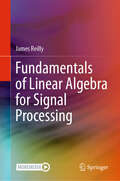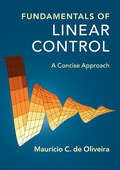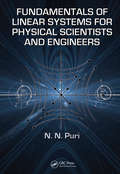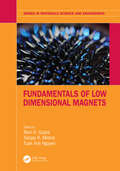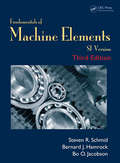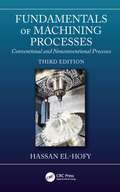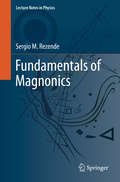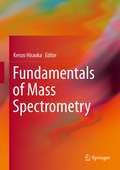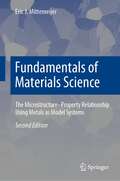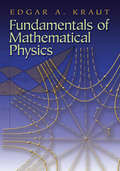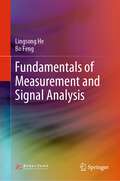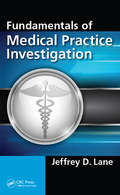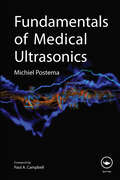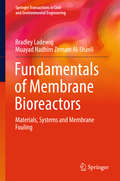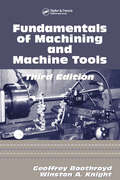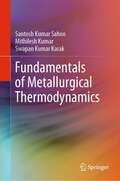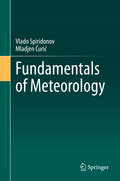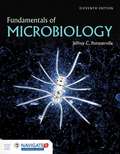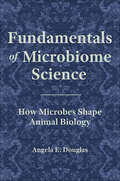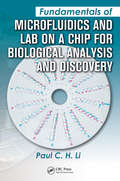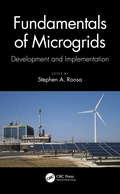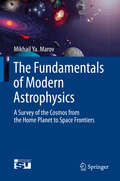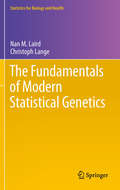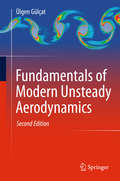- Table View
- List View
Fundamentals of Linear Algebra for Signal Processing
by James ReillySignal processing is ubiquitous in many fields of science and engineering. This textbook is tailored specifically for graduate students and presents linear algebra, which is requisite knowledge in these fields, in a form explicitly targeted to signal processing and related disciplines. Written by an experienced author with over 35 years of expertise in signal processing research and teaching, this book provides the necessary foundation in a focused and accessible manner, offering a practical approach to linear algebra without sacrificing rigor. Emphasis is placed on a deeper conceptualization of material specific to signal processing so students may more readily adapt this knowledge to actual problems in the field. Since other emerging areas, such as machine learning, are closely related to signal processing, the book also provides the necessary background in this discipline. The book includes many examples and problems relevant to signal processing, offering explanations and insights that are difficult to find elsewhere. Fundamentals of Linear Algebra for Signal Processing will allow students to master the essential knowledge of linear algebra for signal processing. It is also an essential guide for researchers and practitioners in biomedical, electrical, chemical engineering, and related disciplines.
Fundamentals of Linear Control: A Concise Approach
by Maurício C. De OliveiraTaking a different approach from standard thousand-page reference-style control textbooks, Fundamentals of Linear Control provides a concise yet comprehensive introduction to the analysis and design of feedback control systems in fewer than 400 pages. The text focuses on classical methods for dynamic linear systems in the frequency domain. The treatment is, however, modern and the reader is kept aware of contemporary tools and techniques, such as state space methods and robust and nonlinear control. Featuring fully worked design examples, richly illustrated chapters, and an extensive set of homework problems and examples spanning across the text for gradual challenge and perspective, this textbook is an excellent choice for senior-level courses in systems and control or as a complementary reference in introductory graduate level courses. The text is designed to appeal to a broad audience of engineers and scientists interested in learning the main ideas behind feedback control theory. Provides a comprehensive yet concise introduction to the analysis and design of feedback control systems, with the required content presented in less than 400 pages, versus the typical thousand-page standard control textbooks presently available. Features fully worked examples and richly illustrated chapters, complemented by an extensive set of homework problems with activities in MATLAB®, allowing students to gain valuable hands-on experience by solving select problems which span across chapters. Offers a complete teaching package on the companion website that include all MATLAB® scripts to generate all figures and tables in the book and a complete solutions manual.
Fundamentals of Linear Systems for Physical Scientists and Engineers
by N.N. PuriThanks to the advent of inexpensive computing, it is possible to analyze, compute, and develop results that were unthinkable in the '60s. Control systems, telecommunications, robotics, speech, vision, and digital signal processing are but a few examples of computing applications. While there are many excellent resources available that focus on one
Fundamentals of Low Dimensional Magnets (Series in Materials Science and Engineering)
by Ram K. Gupta Sanjay Mishra Tuan Anh NguyenA low-dimensional magnet is a key to the next generation of electronic devices. In some respects, low-dimensional magnets refer to nanomagnets (nanostructured magnets) or single-molecule magnets (molecular nanomagnets). They also include the group of magnetic nanoparticles, which have been widely used in biomedicine, technology, industries, and environmental remediation.Low-dimensional magnetic materials can be used effectively in the future in powerful computers (hard drives, magnetic random-access memory, ultra-low power consumption switches, etc.). The properties of these materials largely depend on the doping level, phase, defects, and morphology. This book covers various nanomagnets and magnetic materials. The basic concepts, various synthetic approaches, characterizations, and mathematical understanding of nanomaterials are provided. Some fundamental applications of 1D, 2D, and 3D materials are covered.This book provides the fundamentals of low-dimensional magnets along with synthesis, theories, structure-property relations, and applications of ferromagnetic nanomaterials. This book broadens our fundamental understanding of ferromagnetism and mechanisms for realization and advancement in devices with improved energy efficiency and high storage capacity.
Fundamentals of Machine Elements: SI Version
by Steven R. Schmid Bernard J. Hamrock Bo. O. JacobsonNew and Improved SI Edition-Uses SI Units Exclusively in the TextAdapting to the changing nature of the engineering profession, this third edition of Fundamentals of Machine Elements aggressively delves into the fundamentals and design of machine elements with an SI version. This latest edition includes a plethora of pedagogy, providing a greater u
Fundamentals of Machining Processes: Conventional and Nonconventional Processes, Third Edition
by Hassan El-HofyWritten by an expert with over 40 years of experience in research and teaching machining and related topics, this new edition textbook presents the principles and theories of material removal and applications for conventional, nonconventional and hybrid machining processes. The new edition is ideal for undergraduate students in production, materials, industrial, mechatronics, marine, mechanical, and manufacturing engineering programs, and also useful for graduate programs related to higher-level machining topics, as well as professional engineers and technicians. All chapters are updated, with additional chapters covering new topics of composite machining, vibration assisted machining and mass finishing operations.
Fundamentals of Magnonics (Lecture Notes in Physics #969)
by Sergio M. RezendeFundamentals of Magnonics is a textbook for beginning graduate students in the areas of magnetism and spintronics. The level of presentation assumes only basic knowledge of the origin of magnetism and electromagnetism, and quantum mechanics. The book utilizes elementary mathematical derivations, aimed mainly at explaining the physical concepts involved in the phenomena studied and enabling a deeper understanding of the experiments presented. Key topics include the basic phenomena of ferromagnetic resonance in bulk materials and thin films, semi-classical theory of spin waves, quantum theory of spin waves and magnons, magnons in antiferromagnets, parametric excitation of magnons, nonlinear and chaotic phenomena, Bose-Einstein condensation of magnons, and magnon spintronics. Featuring end-of-chapter problem sets accompanied by extensive contemporary and historical references, this book provides the essential tools for any graduate or advanced undergraduate-level course of studies on the emerging field of magnonics.
Fundamentals of Mass Spectrometry
by Kenzo HiraokaMost research and all publications in mass spectrometry address either applications or practical questions of procedure. This book, in contrast, discusses the fundamentals of mass spectrometry. Since these basics (physics, chemistry, kinetics, and thermodynamics) were worked out in the 20th century, they are rarely addressed nowadays and young scientists have no opportunity to learn them. This book reviews a number of useful methods in mass spectrometry and explains not only the details of the methods but the theoretical underpinning.
Fundamentals of Materials Science: The Microstructure–Property Relationship Using Metals as Model Systems (Graduate Texts In Physics Ser.)
by Eric J. MittemeijerThis textbook offers a strong introduction to the fundamental concepts of materials science. It conveys the quintessence of this interdisciplinary field, distinguishing it from merely solid-state physics and solid-state chemistry, using metals as model systems to elucidate the relation between microstructure and materials properties.Mittemeijer's Fundamentals of Materials Science provides a consistent treatment of the subject matter with a special focus on the microstructure-property relationship. Richly illustrated and thoroughly referenced, it is the ideal adoption for an entire undergraduate, and even graduate, course of study in materials science and engineering. It delivers a solid background against which more specialized texts can be studied, covering the necessary breadth of key topics such as crystallography, structure defects, phase equilibria and transformations, diffusion and kinetics, and mechanical properties. The success of the first edition has led to this updated and extended second edition, featuring detailed discussion of electron microscopy, supermicroscopy and diffraction methods, an extended treatment of diffusion in solids, and a separate chapter on phase transformation kinetics.“In a lucid and masterly manner, the ways in which the microstructure can affect a host of basic phenomena in metals are described.... By consistently staying with the postulated topic of the microstructure - property relationship, this book occupies a singular position within the broad spectrum of comparable materials science literature .... it will also be of permanent value as a reference book for background refreshing, not least because of its unique annotated intermezzi; an ambitious, remarkable work.” G. Petzow in International Journal of Materials Research. “The biggest strength of the book is the discussion of the structure-property relationships, which the author has accomplished admirably.... In a nutshell, the book should not be looked at as a quick ‘cook book’ type text, but as a serious, critical treatise for some significant time to come.” G.S. Upadhyaya in Science of Sintering. “The role of lattice defects in deformation processes is clearly illustrated using excellent diagrams . Included are many footnotes, ‘Intermezzos’, ‘Epilogues’ and asides within the text from the author’s experience. This ..... soon becomes valued for the interesting insights into the subject and shows the human side of its history. Overall this book provides a refreshing treatment of this important subject and should prove a useful addition to the existing text books available to undergraduate and graduate students and researchers in the field of materials science.” M. Davies in Materials World.
Fundamentals of Mathematical Physics (Dover Books on Physics)
by Edgar A. KrautIndispensable for students of modern physics, this text provides the necessary background in mathematics for the study of electromagnetic theory and quantum mechanics. Clear discussions explain the particulars of vector algebra, matrix and tensor algebra, vector calculus, functions of a complex variable, integral transforms, linear differential equations, and partial differential equations. This volume collects under one cover the mathematical ideas formerly available only by taking many separate courses. It offers in-depth treatments, with a minimum of mathematical formalism. Suitable for students of physics, allied sciences, and engineering, its only prerequisites are a course in introductory physics and a course in calculus. Examples at the end of each chapter reinforce many important techniques developed in the text, and numerous graded problems make this volume suitable for independent study.
Fundamentals of Measurement and Signal Analysis
by Lingsong He Bo FengThis book introduces the basic analysis methods in signal processing, principles of various sensors and the concept of measurement system. To make students better understand and apply the theories, the book includes many MATLAB examples, such as the generation of standard signals and the spectrum analysis of audio signals in the signal processing part and Arduino examples as well, such as temperature measuring and ultrasonic ranging to show the applications of sensors. Readers can not only learn the fundamental theories but also get many opportunities to apply the theories to perform measurement tasks.
Fundamentals of Medical Practice Investigation
by Jeffrey D. LaneFundamentals of Medical Practice Investigation fills an important gap in the resources for criminal investigators. Appropriate for novice medical investigators as well as seasoned investigators looking to sharpen their skills, this book unites step-by-step fundamentals with up-to-date research reviews of critical issues in the field, including sexual misconduct, patient abuse, drug use among medical practitioners, and unethical or illegal prescription practices. An essential tool for law enforcement and other criminal justice professionals, Fundamentals of Medical Practice Investigation will improve the quality of all types of medical investigation.
Fundamentals of Medical Ultrasonics
by Michiel PostemaUltrasonic imaging is an economic, reliable diagnostic technique. Owing to recent therapeutic applications, understanding the physical principles of medical ultrasonics is becoming increasingly important. Covering the basics of elasticity, linear acoustics, wave propagation, nonlinear acoustics, transducer components, ultrasonic imaging modes, basi
Fundamentals of Membrane Bioreactors
by Bradley Ladewig Muayad Nadhim Zemam Al-ShaeliThis book provides a critical, carefully researched, up-to-date summary of membranes for membrane bioreactors. It presents a comprehensive and self-contained outline of the fundamentals of membrane bioreactors, especially their relevance as an advanced water treatment technology. This outline helps to bring the technology to the readers' attention, and positions the critical topic of membrane fouling as one of the key impediments to its more widescale adoption. The target readership includes researchers and industrial practitioners with an interest in membrane bioreactors.
Fundamentals of Metal Machining and Machine Tools
by Winston A. Knight Geoffrey BoothroydReflecting changes in machining practice, Fundamentals of Machining and Machine Tools, Third Edition emphasizes the economics of machining processes and design for machining. This edition includes new material on super-hard cutting tool materials, tool geometries, and surface coatings. It describes recent developments in high-speed machining, hard machining, and cutting fluid applications such as dry and minimum-quantity lubrication machining. It also presents analytical methods that outline the limitations of various approaches. This edition features expanded information on tool geometries for chip breaking and control as well as improvements in cost modeling of machining processes.
Fundamentals of Metallurgical Thermodynamics
by Santosh Kumar Sahoo Mithilesh Kumar Swapan Kumar KarakThis book highlights introduction of thermodynamics; first law, second law, third law of thermodynamics and their applications; concepts of entropy, free energies, thermodynamic equilibrium, thermodynamic activity and fugacity; Maxwell relations; Gibbs-Helmholtz equation; Clausis-Clayperon equation, etc. have been discussed in detail and made easily understandable to the undergraduate students of metallurgy. Thermodynamics involved in formation of different types of solutions (ideal, real and regular solutions) has also been discussed in detail. This book also discusses the applications of various thermodynamic properties in different metallurgical operations. At the end of each and every chapter, different types of typical related problems have also been solved.
Fundamentals of Meteorology
by Vlado Spiridonov Mladjen ĆurićThis book is dedicated to the atmosphere of our planet, and discusses historical and contemporary achievements in meteorological science and technology for the betterment of society. The book explores many significant atmospheric phenomena and physical processes from the local to global scale, as well as from the perspective of short and long-term time scales, and links these processes to various applications in other scientific disciplines with linkages to meteorology. In addition to addressing general topics such as climate system dynamics and climate change, the book also discusses atmospheric boundary layer, atmospheric waves, atmospheric chemistry, optics/photometeors, electricity, atmospheric modeling and numeric weather prediction. Through its interdisciplinary approach, the book will be of interest to researchers, students and academics in meteorology and atmospheric science, environmental physics, climate change dynamics, air pollution and human health impacts of atmospheric aerosols.
Fundamentals of Microanalytical Entomology: A Practical Guide to Detecting and Identifying Filth in Foods
by ALAN R. OLSEN; THOMAS H. SIDEBOTTOM; SHERRY A. KNIGHTThis text offers insight into the practical applications of microanalytical entomology in the laboratory and in the field of consumer protection. This is the only guide that gives an overview of the subject from initial analysis of a product to interpreting significance of final results. Complete insect illustrations throughout and an insect fragment identification discussion covers all pests that are found in foods. Micrographs illustrate a complete reference on identifying types of hair contaminants found in various foods. Chapters are written by practicing regulatory experts.
Fundamentals Of Microbiology
by Jeffrey PommervilleHighly suitable for non-science majors, the fully revised and updated third edition of this bestselling text contains new pedagogical elements and an established learning design format that improves comprehension and retention and makes learning more enjoyable. Unlike other texts in the field, Fundamentals of Microbiology: Body Systems Edition takes a global perspective on microbiology and infectious disease, and supports students in self-evaluation and concept absorption. Furthermore, it includes real-life examples to help students understand the significance of a concept and its application in today's world, whether to their local community or beyond. New information pertinent to nursing and health sciences has been added, while many figures and tables have been updated, revised, and/or reorganized for clarity. Important Notice: The digital edition of this book is missing some of the images or content found in the physical edition.
Fundamentals of Microbiome Science: How Microbes Shape Animal Biology
by Angela E. DouglasAn essential introduction to microbiome science, a new cutting-edge discipline that is transforming the life sciencesThis book provides an accessible and authoritative guide to the fundamental principles of microbiome science, an exciting and fast-emerging new discipline that is reshaping many aspects of the life sciences. Resident microbes in healthy animals--including humans—can dictate many traits of the animal host. This animal microbiome is a second immune system conferring protection against pathogens; it can structure host metabolism in animals as diverse as reef corals and hibernating mammals; and it may influence animal behavior, from social recognition to emotional states. These microbial partners can also drive ecologically important traits, from thermal tolerance to diet, and have contributed to animal diversification over long evolutionary timescales.Drawing on concepts and data across a broad range of disciplines and systems, Angela Douglas provides a conceptual framework for understanding these animal-microbe interactions while shedding critical light on the scientific challenges that lie ahead. Douglas explains why microbiome science demands creative and interdisciplinary thinking—the capacity to combine microbiology with animal physiology, ecological theory with immunology, and evolutionary perspectives with metabolic science.An essential introduction to a cutting-edge field that is revolutionizing the life sciences, this book explains why microbiome science presents a more complete picture of the biology of humans and other animals, and how it can deliver novel therapies for many medical conditions and new strategies for pest control.
Fundamentals of Microfluidics and Lab on a Chip for Biological Analysis and Discovery
by Paul C.H. LiLab-on-a-chip technology permits us to make many important discoveries that can only be observed at the microscale or the nanoscale. Using this technology, biological and biochemical analyses translate into greater sensitivity, more accurate results, and more valuable findings. Authored by one of the field's pioneering researchers, Fundamentals of
Fundamentals of Microgrids: Development and Implementation
by Stephen A. RoosaMicrogrids provide opportunities to develop new electrical networks targeted for the needs of communities. The fourth industrial revolution is associated with the global trend toward decentralizing energy grids. Within this context, microgrids are seen as a solution to how renewable electricity can be supplied to local areas. The Fundamentals of Microgrids: Development and Implementation provides an in-depth examination of microgrid energy sources, applications, technologies, and policies. This book considers the fundamental configurations and applications for microgrids and examines their use as a means of meeting international sustainability goals. It focuses on questions and issues associated with microgrid topologies, development, implementation and regulatory issues. Distributed energy resources are defined, stand-a-lone generation systems are described and examples of typical microgrid configurations are provided. The key components of developing a business model for microgrid development are also considered. Features: Describes what microgrids are and details the basics of how they work while considering benefits of microgrids and their disadvantages. Provides answers to the fundamental questions energy managers and other professionals want to know about the basics of microgrids. Details the applications for microgrids and demystifies the types of microgrid architectures that are successful. Includes real-world examples of functioning microgrids which provide models for the development of microgrids in the future. Discusses the key considerations that must be addressed to develop a business case for microgrid development.
The Fundamentals of Modern Astrophysics
by Mikhail Ya. MarovThe Fundamentals of Modern Astrophysics provides an overview of the modern science of astrophysics. It covers the Sun, Solar System bodies, exoplanets, stars, and star life cycle, planetary systems origin and evolution, basics of astrobiology, our galaxy the Milky Way, other galaxies and galactic clusters, a general view of the Universe, its structure, evolution and fate, modern views and advanced models of cosmology as well as the synergy of micro- and macro physics, standard model, superstring theory, multiversity and worm holes. The main concepts of modern astrophysics and prospects for future studies are accompanied by numerous illustrations and a summary of the advanced projects at various astronomical facilities and space missions. Dr. Marov guides readers through a maze of complicated topics to demystify the field and open its wonders to all.
The Fundamentals of Modern Statistical Genetics
by Nan M. Laird Christoph LangeThis book covers the statistical models and methods that are used to understand human genetics, following the historical and recent developments of human genetics. Starting with Mendel's first experiments to genome-wide association studies, the book describes how genetic information can be incorporated into statistical models to discover disease genes. All commonly used approaches in statistical genetics (e.g. aggregation analysis, segregation, linkage analysis, etc), are used, but the focus of the book is modern approaches to association analysis. Numerous examples illustrate key points throughout the text, both of Mendelian and complex genetic disorders. The intended audience is statisticians, biostatisticians, epidemiologists and quantitatively- oriented geneticists and health scientists wanting to learn about statistical methods for genetic analysis, whether to better analyze genetic data, or to pursue research in methodology. A background in intermediate level statistical methods is required. The authors include few mathematical derivations, and the exercises provide problems for students with a broad range of skill levels. No background in genetics is assumed.
Fundamentals of Modern Unsteady Aerodynamics
by Ülgen GülçatIn this textbook, the author introduces the concept of unsteady aerodynamics and its underlying principles. He provides the readers with a full review of fundamental physics of the free and the forced unsteadines, the terminology and basic equations of aerodynamics ranging from incompressible flow to hypersonics. The book also covers the modern topics concerning the developments made during the last years, especially in relation to wing flappings for propulsion. The book is written for graduate and senior year undergraduate students in Aerodynamics, and it serves as a reference for experienced researchers. Each chapter includes ample examples, questions, problems and relevant references.
